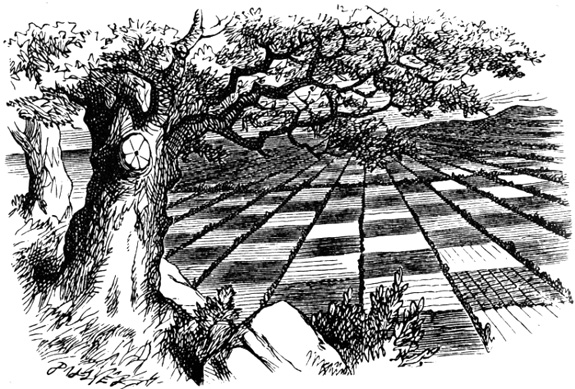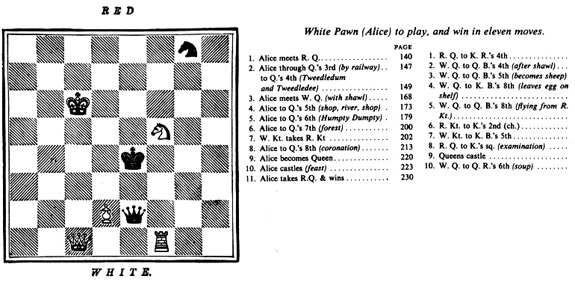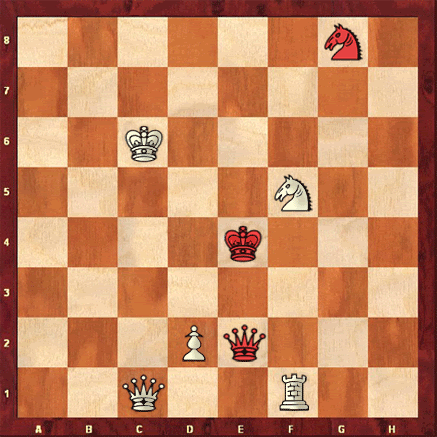
Painters, sculptors and musicians have long since found inspiration in the complex movement of thirty-two pieces across a chessboard. But writers too have found inspiration in the 64 square battlefield. Perhaps none moreso than Charles Lutwidge Dodgson aka Lewis Carroll aka the writer of Alice’s Adventures in Wonderland and Through the Looking-Glass and What Alice Found There. Whereas in the first story, Alice encountered a kingdom of playing cards after falling down the rabbit hole, in the sequel, she stepped through a mirror to find an entirely new wonderland populated by anthropomorphic red and white chessmen.
It makes sense that the two dominant symbols of the story are the mirror and the chess board—after all, the pieces on a board at the start of play are a reflection of one another. But chess wasn’t just a recurring motif or symbol in Carroll’s story, it was, in fact, the basis for the novel’s structure. The story was designed around a game of chess. This is made explicit from the very beginning of the book, when the reader is confronted with a chess problem and the following note: “White Pawn (Alice) to play, and win in eleven moves.”

This opening salvo perplexed readers more than the frumious language of “Jabberwocky.” Although the problem is a sort of funhouse mirror distortion of the novel (or vice versa), with eleven moves roughly corresponding to the book’s twelve chapters, Carroll’s notation displays a flagrant disregard for the basic rules of chess. At best, it was viewed as a careless game, even with the explanatory Dramatis Personae included with early versions of the text that equated every character with a corresponding piece. In response to concerns and criticisms, Carroll included a preface to the 1896 edition of Through the Looking Glass, addressing the opening chess problem:
As the chess-problem…has puzzled some of my readers, it may be well to explain that it is correctly worked out, so far as the moves are concerned. The alternation of Red and White is perhaps not so strictly observed as it might be, and the “castling” of the three Queens is merely a way of saying that they entered the palace; but the “check” of the White King at move 6, the capture of the Red Knight at move 7, and the final “checkmate” of the Red King, will be found, by anyone who will take the trouble to set the pieces and play the moves as directed, to be strictly in accordance to the laws of the game.
So while Carroll admits taking some liberties with the game, the logic is, in his view at least, sound. Furthermore, although many of the moves listed in the introductory problem make no sense if taken on their own, when they are considered in the context of the story, a strange logic emerges, a logic based not on the rules of chess, but on Carroll’s narrative. For example, as Martin Gardner points out in an analysis of Carroll’s game in The Annotated Alice, “At two points the White Queen passes up a chance to checkmate and on another occasion she flees from the Red Knight when she could shave captured him. Both oversights, however, are in keeping with her absent-mindedness.” By Gardner’s theory then, the mistakes are designed into the story. The White Queen, who famously believed in “six impossible things before breakfast,” also experiences time in reverse, which, from the perspective of a game piece, would surely result in unpredictable movement and a curious perception of the board.

Another example of narrative’s influence on the opening problem can be seen when the Red Queen puts the White King in check at move 8, but the condition is neither included in the game’s notation nor addressed in the story. However, this too can be explained by considering the rules of both. According to the rules of chess, when a player is put in check, it must be announced. Otherwise, the check can be ignored. Gardner cites an article by artist Ivor Davies, who rationalizes the antagonistic Red Queen’s behavior with evidence from the story itself, noting that the silence was “entirely logical because, at the moment of her arrival at King one, she said to Alice. ‘Speak when you’re spoken to!’ Since no one had spoken to her she would have been breaking her own rule had she said ‘check.'”

There are myriad other connections between Carroll’s story and his introductory chess problem, and perhaps even more interpretations and analyses of said chess problem. But in all the scholarship surrounding Through the Looking Glass and What Alice Found There, it’s clear that the story cannot be isolated as a either chess treatise or a children’s story. It’s both. The novel’s structure is determined according to a prescribed series of chess moves; the actions and behaviors of its characters are largely dictated by the limitations and characteristics of their corresponding pieces. But this interdependence means that the pieces are themselves influenced by character traits established in the story. The narrative abides by the logic of the game and the game abides by the logic of the narrative. Lewis Carrroll’s story is quite literally a game-changer.
This article originally appeared on Design Decoded
Related content: